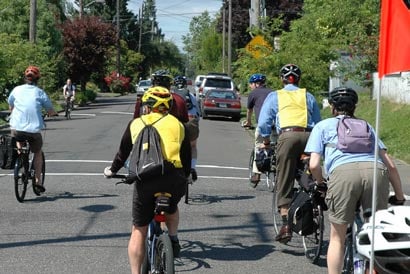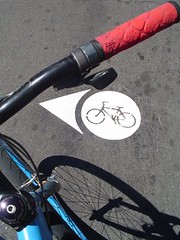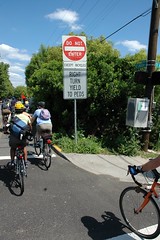
Bicycle boulevards — which are adored by both PDOT and the BTA — are a major buzzword among bicycle transportation gurus nationwide.
First, let’s be clear on what they are. In Portland, bike boulevards are easily bike-able routes, marked by improved intersection crossings, wayfinding signage, traffic calming features and those little white circles on the pavement.
“The City of Portland needs to do the logical thing and ban motor vehicle traffic from bike boulevards.”
On their bike boulevard page, the BTA writes, “In talking to nearly 1,000 cyclists as part of our Blueprint for Better Biking study, we heard loud and clear that the number one concern of current and potential cyclists is biking around cars.”
I agree, bike Boulevards are great. They’re pleasurable and fast to ride on, they make navigating major intersections much easier, and you’re nearly always in the company of other cyclists.
They aren’t perfect though. Not yet.

The roads are often poorly maintained (it’s been proposed that bicycle boulevards be given maintenance priority over other neighborhood streets), the connections are not always seamless, and special bicycle crosswalk buttons, such as the new one at E 41st and Burnside, are sometimes accessible only after braving a pedal-deep puddle of moldy leaves.
Most problematic of all, car traffic can be heavier, and faster, than billed.
One of the complaints about bicycle boulevards, like SE Clinton and SE Salmon, is that traffic speed increases when you “turn” stop signs away from a street. As soon as drivers catch on, the low-traffic street becomes less so, even with devices that prevent cars from turning onto the boulevards from major streets, such as at SE 39th and Clinton.
The City of Portland needs to do the logical thing and ban motor vehicle traffic from bike boulevards.
It would be ideal to ban all car-traffic, and this option should be offered to each block on bicycle boulevards (and elsewhere, for that matter). But we’re not there yet. Neighbors need access to their driveways, partygoers to their dinner parties, kids and workers to their carpools, kind old Mrs. G. to her TriMet Lift van.
“With a broader canvas, human-powered traffic can better learn to share the road.”
Some new infrastructure is needed to allow people car access to their houses, while eliminating through-traffic on bike boulevards. I suggest raised medians with bumps down the center of every cross-street — such as the one on SE 20th where it crosses Ankeny.
These raised concrete bars sport reflectors, and have gaps cut into them for cyclists to pass through. These would prevent people from wanting to drive for more than one block down one of these streets, and would slow traffic on cross-streets as an added benefit. These can’t be expensive — and must be more effective than curb extensions, traffic circles, and the like.
These boulevards could also help us place a priority on pedestrians, and help us find ways to improve the engineering and culture of cyclist-pedestrian interactions. It’s unfair to squeeze people on foot and on bicycle into the narrowest margins at the edge of the public right-of-way, where we can only blame each other for being in each others’ way.
With a broader canvas, human-powered traffic can better learn to share the road.
Eugene, Berkeley, Palo Alto, Vancouver BC, and other bicycle-friendly cities have bike boulevard programs. We have a chance here to outshine them and set an example for the rest of the country — and the world. If nothing else, car-free boulevards in Portland will make low-car-traffic bike boulevards seem less radical.
Someday, car-free streets will be the norm. Now is the time to start setting the platinum standard.



